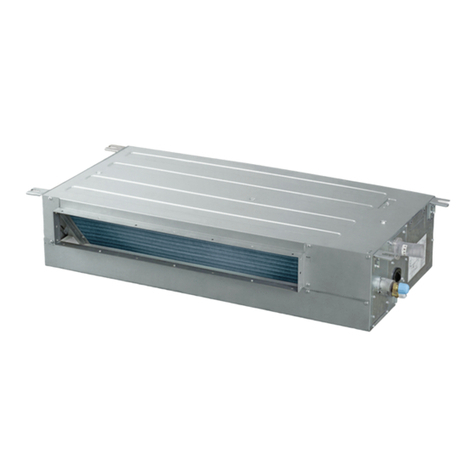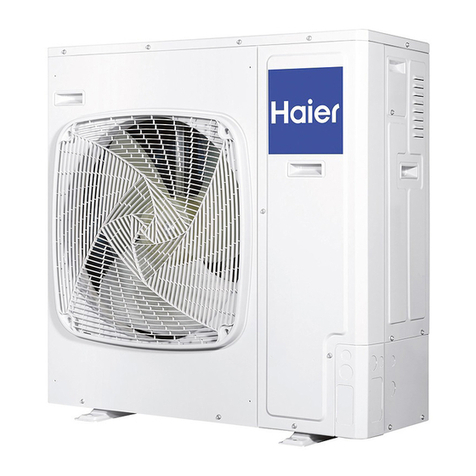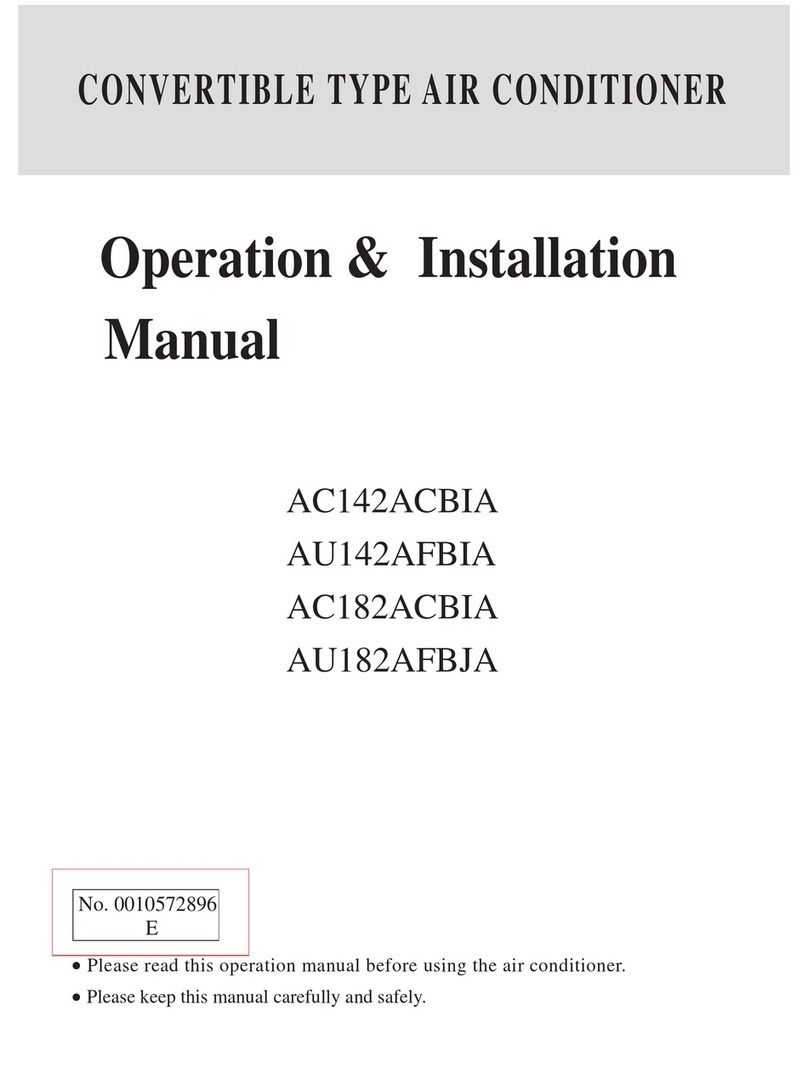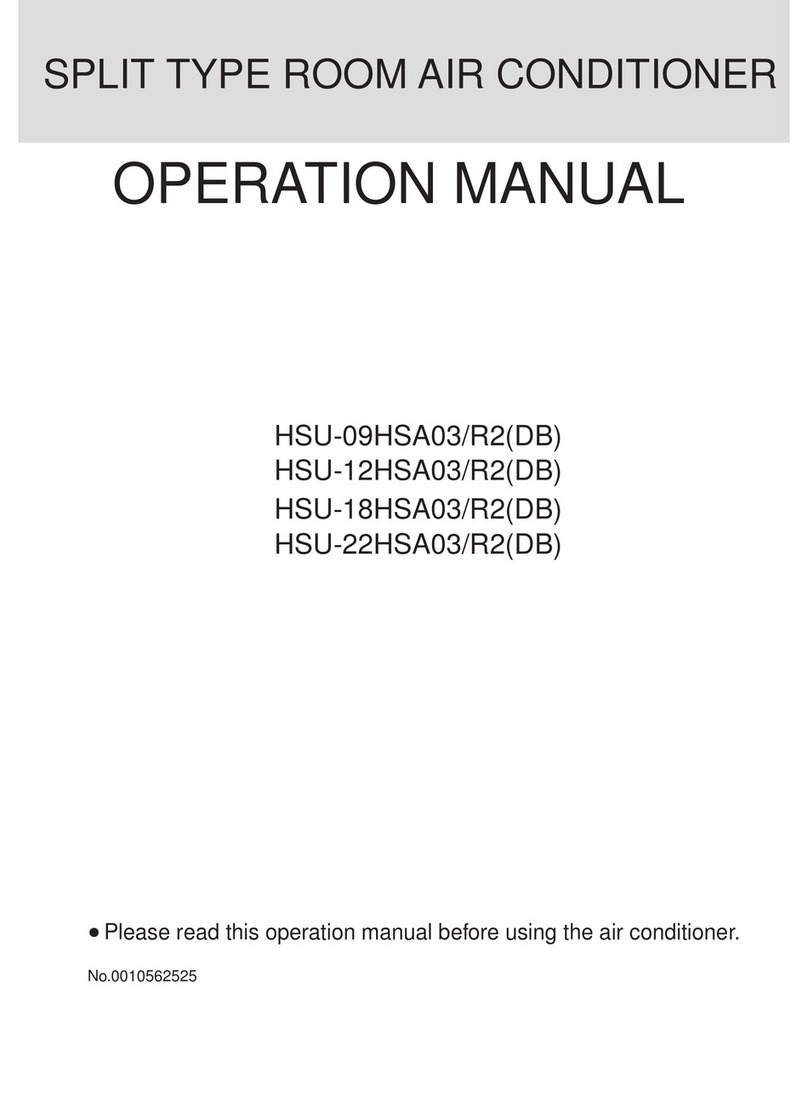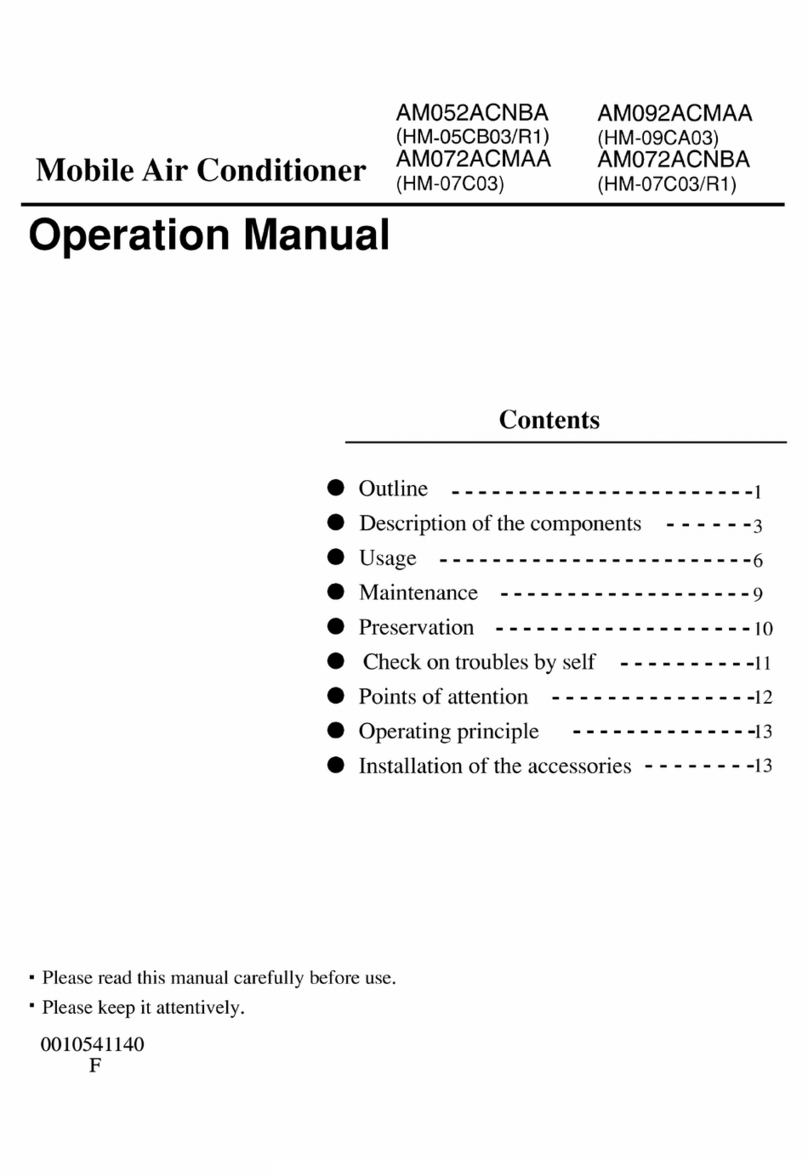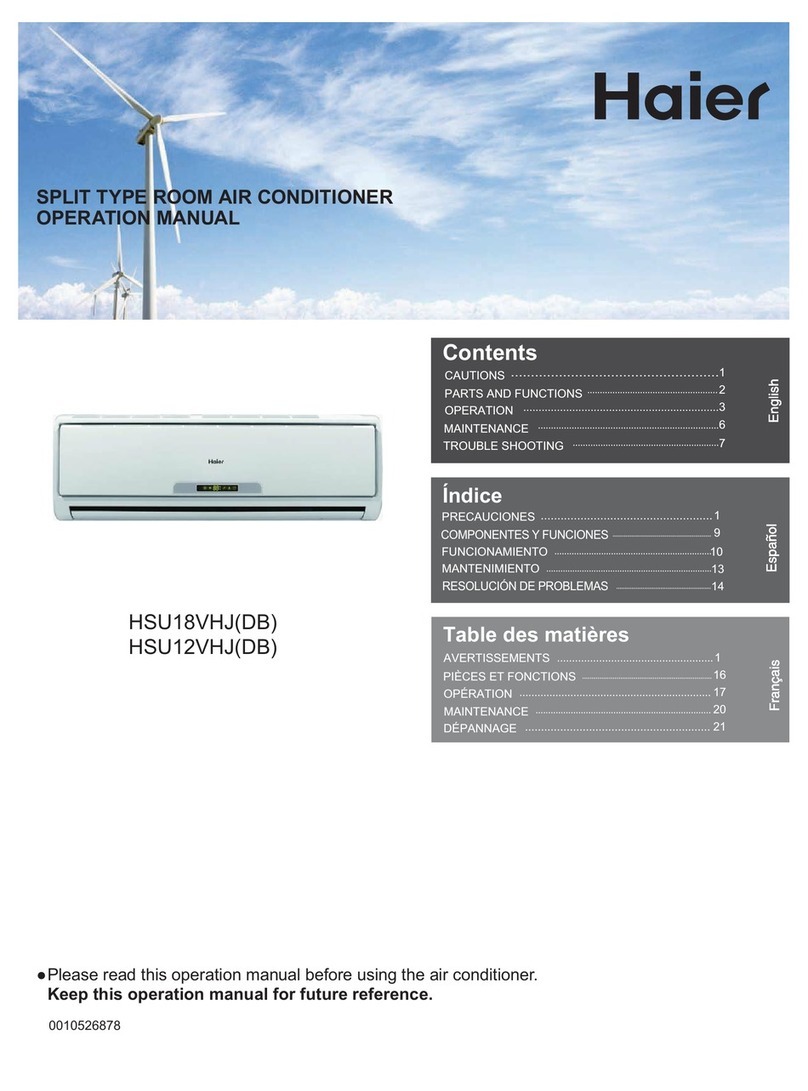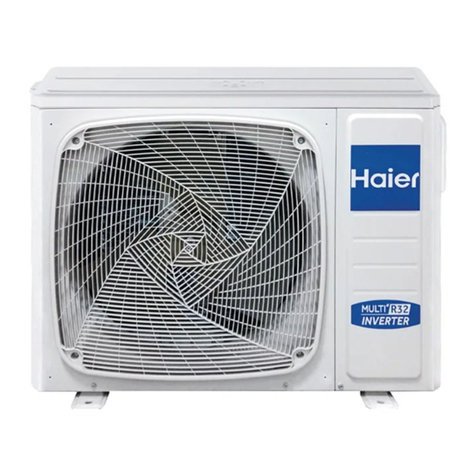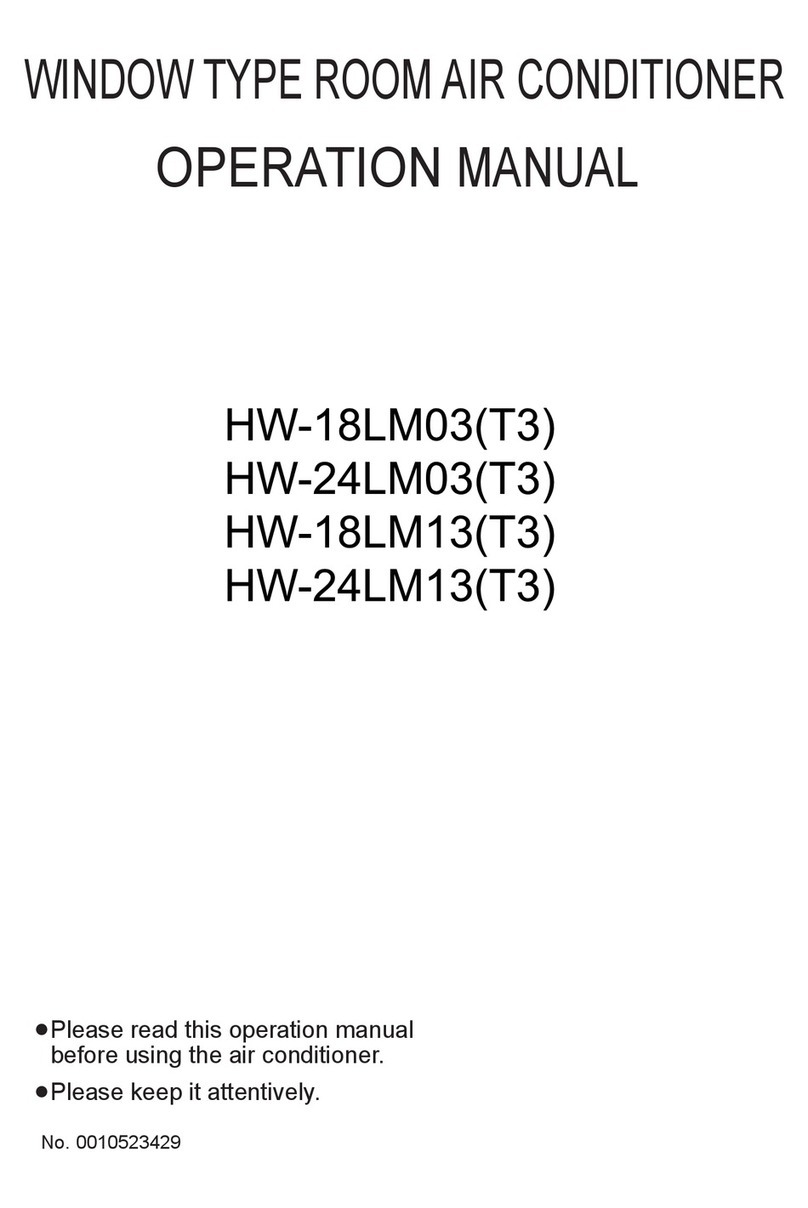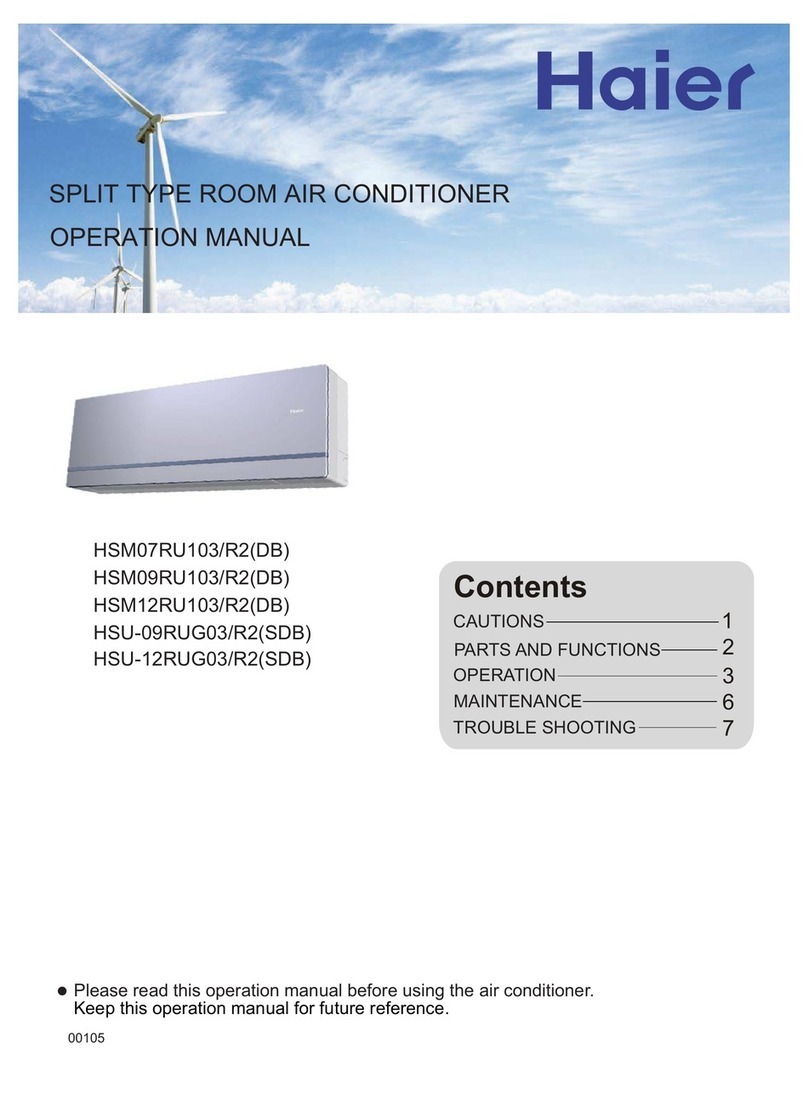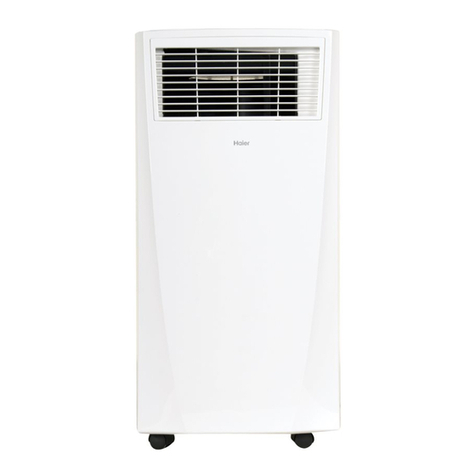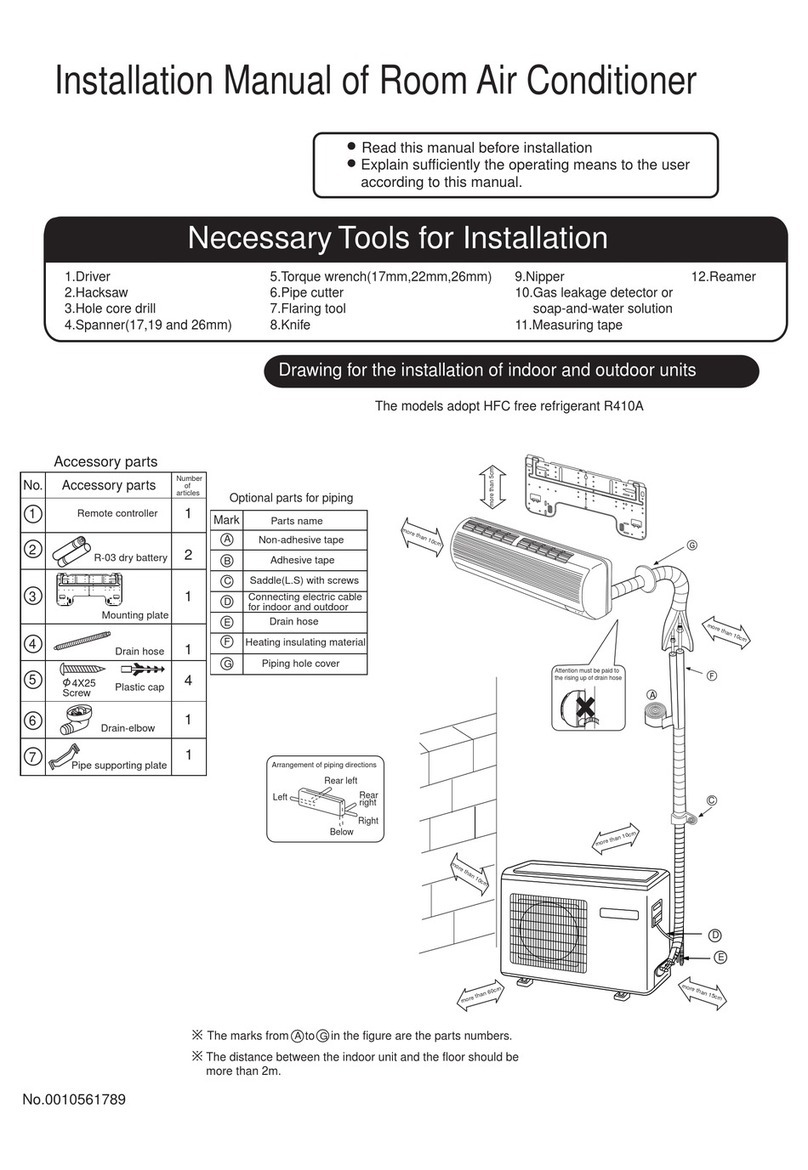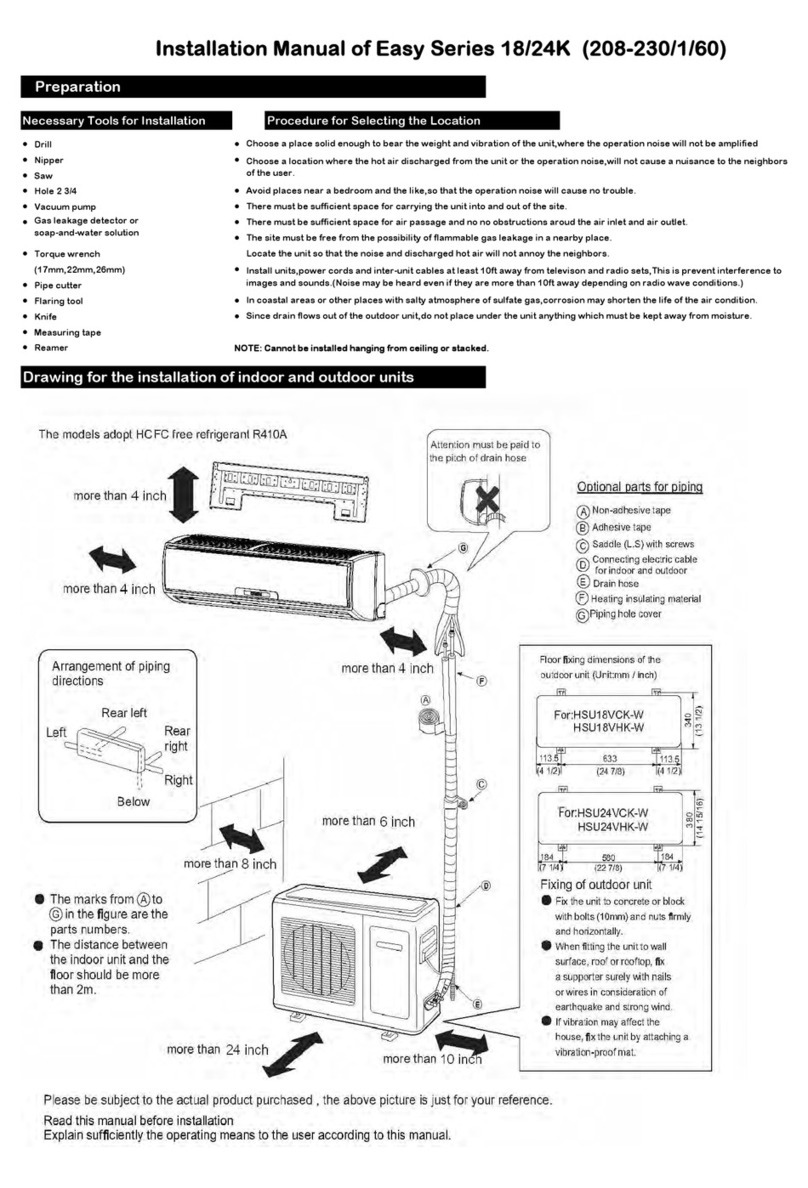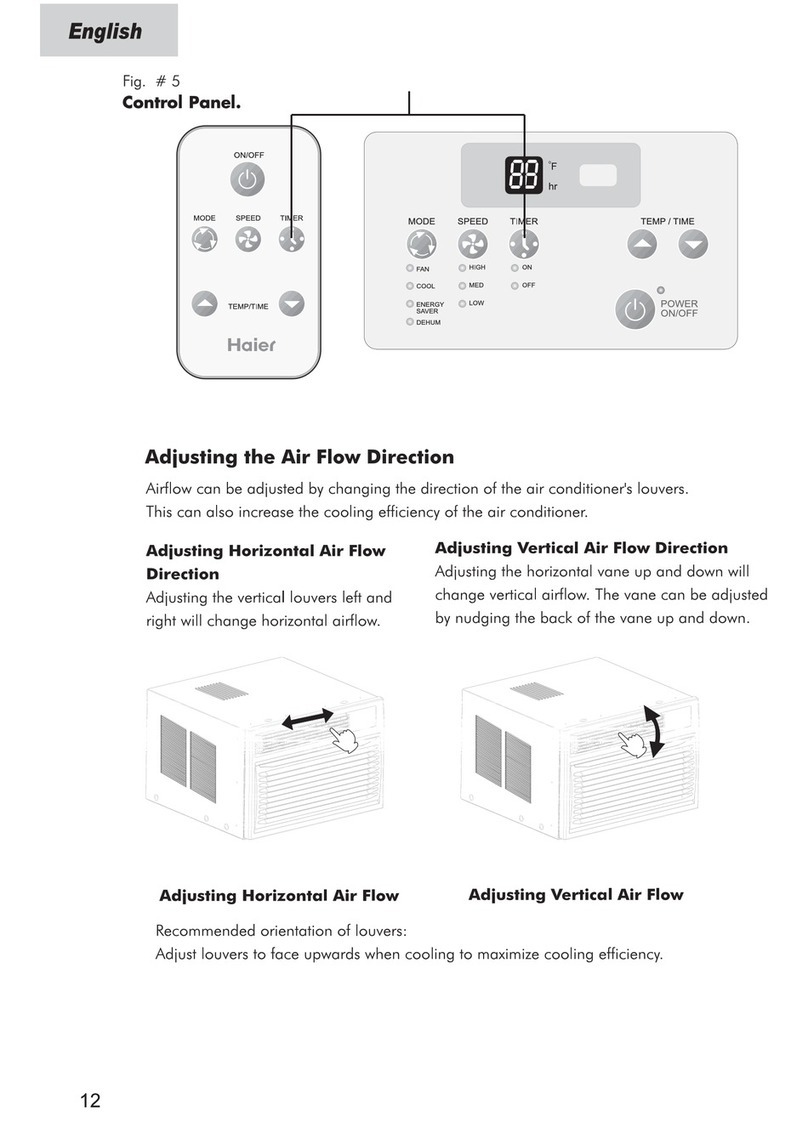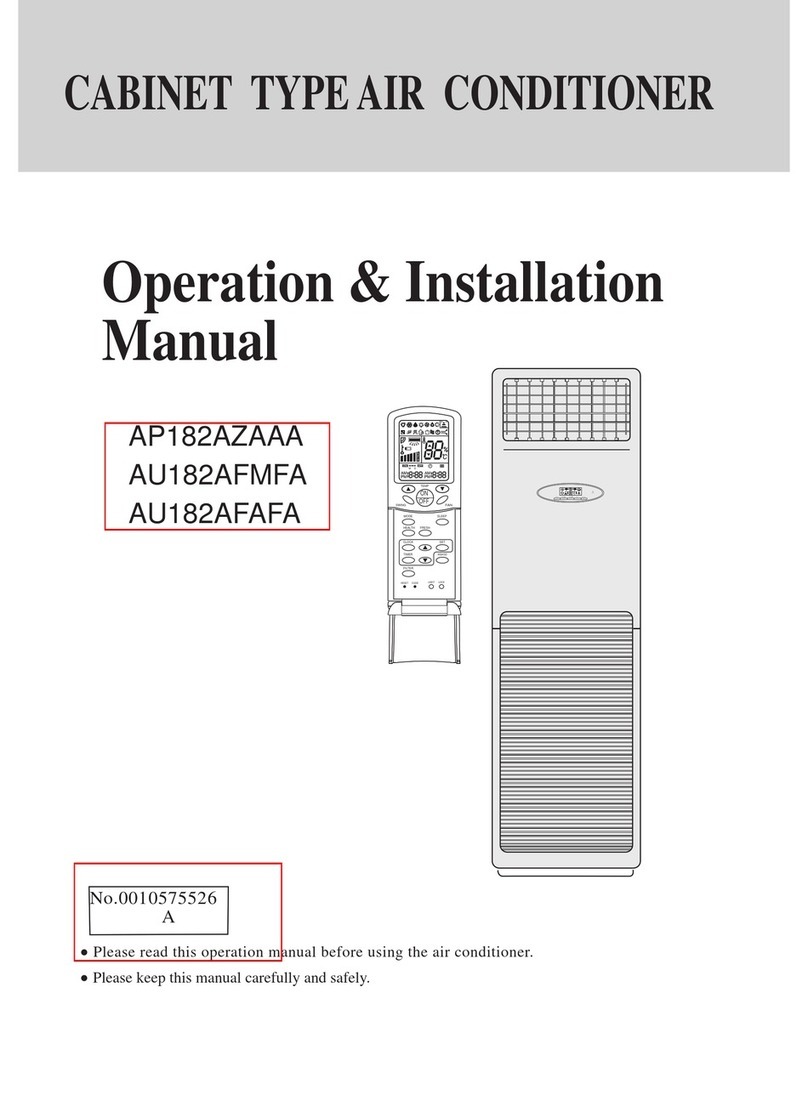
Trouble shooting
7
Before asking for service, check the following first.
Normal
Performance
inspection
Noise is heard
Phenomenon Cause or check points
The system does not restart
immediately.
Smells are generated.
Mist or steam are blown out.
Multiple
check
Poor cooling
When unit is stopped, it won't restart
elapsed to protect the system.
When the electric plug is pulled out
and reinserted, the protection circuit
During unit operation or at stop,
a swishing or gurgling noise may
(This noise is generated by
refrigerant flowing in the system.)
During unit operation, a cracking
noise may be heard.This noise is
temperature changes.
Should there be a big noise from
filter may be too dirty.
This is because the system
circulates smells from the interior
During COOL or DRY operation,
This is due to the sudden cooling
Is power plug inserted?
Is there a power failure?
Is fuse blownout?
Is the air filter dirty?
Are there any obstacles before
Is temperature set correctly?
Are there some doors or
Is there any direct sunlight
through the window during the
Are there too much heat sources
or too many people in the room
In dry mode,
fan
speed can’t be changed.
In DRY mode, when room
than temp.setting+2oC,unit will
regardless of FAN setting.
Maximum: D.B
10.The appliance must be installed on a strong enough support.
9.Young children should be supervised ensure that they do not
play with the appliance.
8.The appliance is not intended to use by young children or infirm
persons without supervision.
7.The used batteries should be disposed of properly.
6.
After installation, the power plug should be easily reached..
5.The wiring method should be in line with the local wiring standard.
4.The distance between the indoor unit and the floor should be
more than 2m.
3. If the fuse on PC board is broken please change it with a fuse
type T. 3.15A/250V.
11.The wiring diagram is attached inside the machine.
2. If the supply cord is damaged, it must be replaced by the
manufacturer or its service agent or a similar qualified
person.
The type of connecting wire is H05RN-F or H07RN-F
Cautions
The machine is adaptive in following situation
1.Applicable ambient temperature range:
Cooling
Heating
Indoor
Outdoor
Outdoor
Indoor
Maximum: D.B / W.B 35
o
C/24
o
C
18
o
C/14
o
C
46
o
C/--
18
o
C
27
o
C
15
o
C
24
o
C/18
o
C
-7
o
C/-8
o
C
Minimum: D.B / W.B
Minimum: D.B
Maximum: D.B
Minimum: D.B
Maximum: D.B / W.B
Minimum: D.B / W.B
For: T1
during cooling operation?
cooling operation?(Use curtain)
windows left open?
inlet and outlet?
Normally it should be cleaned
every 15 days.
run intermittently at LOW speed
temperature becomeslower
indoor unit may blow out mist.
of indoor air.
air such as the smell of furniture,
paint, cigarettes.
air flow in unit operation, air
generated by the casing expanding
or shrinking because of
be heard.At first 2-3 minutes after
unit start, this noise is more noticeable.
will work for 3 minutes to protect the
air conditioner.
immediately until 3 minutes have
If the fuse of outdoor unit on PC board is broken, please change
it with the type of T. 25A/250V.
For: T3
Cooling
Heating
Indoor
Outdoor
Indoor
Outdoor
Maximum: D.B / W.B
Minimum: D.B / W.B
Maximum: D.B / W.B
Minimum: D.B
Maximum: D.B
Minimum: D.B
Maximum: D.B / W.B
Minimum: D.B / W.B
32oC/23oC
18oC/14oC
52oC/31oC
18oC
27oC
15oC
24oC/18oC
-7oC/-8oC
Application temp. range of air conditioner oC~43oC.
Application temp. range of air conditioner -7oC~54oC.
T1:
T3:
E WASTE TOXIC COMPONENT & THEIR DAMAGE TO HUMAN HEALTH
Toxic
Materials
Birth
Defects
Brain
Damage
Heart, Liver ,
Lung & Spleen
Damage
Kidney
Damage
Nervous/
Reproductive
System Damage
Skeletal
System
Damage
Barium
Cadmium
Lead
Lithium
Mercury
Nickel
Palladium
Rhodium
Silver
x
x x
x x x x
xxxx
x x x x x
xxxx
x
x
x
x
x
x
x
x
x
x
x
x
x
x
Without safe recycling, most of these toxic components will end in land fill-poisioning soil and water.
"Why proper handling and management of e-waste :-
The electrical and electronic equipment (EEE) have valuable materials and hazardous/toxics substances in their components. The electronic products and
electrical equipment after their useful life may not cause any harm if it is stored safely in households/stores. However, if the E-waste is opened-up and attempts are
made for retrieval of useful components or material in an un-scientific manner or if the material is disposed in open, then it may cause health risks and damage to
environment. E-waste can be considered as a resource that contains useful material of economic benefit for recovery of plastics, iron, glass, aluminum, copper
and precious metals such as silver, gold, platinum, and palladium and lead, cadmium, mercury etc. However, at the same time presence of heavy metals (As, Cd,
Hg, Pb etc.) and other toxic substances such as polychlorinated biphenyls (PCBs), etched chemicals, etc. may pose risk to health and environment during
handling and recovery operations. E-waste is a problem of increasing proportions especially when crude methods are adopted for recovery of useful components
from E-waste.
Thus, there is a need to encourage OUR SELF for recycling of all useful and valuable material from e-waste so as to conserve the ever depleting natural resources.
Electronic component are increasingly made from recycled materials, for example for making new LCDs, more than 50% of indium is sourced by recycling used
LCDs. The E-waste thus presents a scenario of urban mining for recovery of ferrous/non-ferrous/ rare earth metal and precious metal in addition to plastics and
glass. However, presence of hazardous and toxic substances in the component of e-waste necessitates environmentally sound management of e-waste including
collection and recycling/treatment in an environmentally sound manner.
"Management and Effect on sustainable future:-
Sustainable development as defined by Brundtland Commission is “development that meets the needs of the present without compromising the ability of future
generations to meet their own needs.”
The e-waste since a long time had been seen as an easy and cheapest source of metals. However due to lack of proper consideration for such source of metals as
well as proper methods of recycling in India, we sent our e-waste to the improper channel/scrap vendor and thereby participated in degrading the environment.
Moreover, through this improper method of extraction of metals we till date had wasted approximately 40% of the precious metals and simultaneously caused
damage to our environment. If we opt the proper way to extract metals through proper channel of recycling then we can achieve approximately 90% of extraction
rate of our metals as well as a better way to save our environment. However, if today while selling off our material to improper channel we will not think about our
sustainable future then it is for sure that the coming generations will be facing crisis of the metals.
Customer responsibility
a) consumers shall ensure that there end of life product/e-waste is channelized through collection center or dealer of authorized producer or dismantler or
recycler or through the designated take back serviceprovider of the producer to authorized dismantler or recycler;
b) consumers shall ensure that such end-of-life electrical and electronic equipment are not admixed with e-waste containing radioactive material;
Electronic Waste Recycling:
Do’s
•Handover/Donate/Give the discarded Electronic Equipment’s only at the authorized collection centers.
•Drop the discarded Electronic Equipment’s only in the bins meant for the Electronic Waste.
•Ask the retailer about the Take Back schemes.
•Consult the authorized service center as to whether the Electronic Equipment can be repaired or not, before discarding the same.
•Tell your neighbors and other persons about the hazards of improper disposal or handling or improper recycling of the Electronic Waste.
•If the unwanted Electronic Equipment still work or can be repaired then consider donating them.
•To minimize our impact on the earth and to protect the environment for future generations return your discarded Electronic Equipment’s here for safe recycling
Don’ ts
•Don’t dump the discarded Electronic Equipment’s in open or in any Land Fill Site as the same will result in contaminating the Soil and the ground water.
•Don’t dispose of the discarded Electronic Equipment’s in household bins or Municipal Bins.
•Don’t sell or give your discarded Electronic Equipment’s to any Trash Dealer or Kabadiwala/unauthorized vendor.
•Don't try to open up the product by yourself for repair or other purposes.
•Don't mix the electronic waste into household waste stream.
•Don't keep any replaced spare part(s) from the product in exposed area.Always handover such article to service personal so that same can be recycled.
Introduction
We at Haier in our continuous efforts of making a future better adopted eco-friendly practices and procedures. We acting towards our
social, moral and statutory responsibility towards the environment and sustainable development have pledged to recycle electronic items,
such as TV/LED/LCD, refrigerator, AC etc. that are no longer useful. Haier is stepping towards leading a more conservation and
optimization of resources and thereby making environment safer. We request you to donate or utilize take back scheme for your electronic
good when it reaches its end-of-life, so that it can be reuse -recycle and reinvent.
"Hazard of e waste on environment and Human Health :-
The informal method of recycling extends health hazards. Primary and secondary exposure to toxic metals, such as lead, results in
diseases like Heart, Liver, Lung & Spleen Damage. Open-air burning of electronic waste, used to retrieve valuable components such as
gold, not only causes damages to environment but also to human health. Incineration from burning e-waste creates fine particulate matter,
which is linked to heart and respiratory disease. However the above said is only example and the informal way to recycle causes numerous health hazards. During
such informal recycling no caution or care are kept to either secure the environment or human health. The informal method of recycling extended environment
hazards too. For example when different e-waste is burnt to extract metals from it, toxic chemicals are released in to the air, damaging the atmosphere. Such
informal ways creates noise, water and air pollution.
18
